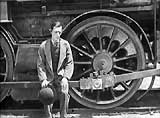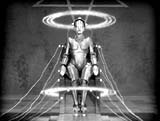
|
GREATEST FILM SCENES The Silents (2) |
| Film Title/Year and Film Scene Description | |
|
# 8. The Phantom of the Opera (1925) The frightening, eerie moment that the mad Erik (Lon Chaney, Sr.), the horribly disfigured phantom of the opera, is unmasked and shows his "accursed ugliness" is in Universal's definitive silent horror classic. The phantom is in love with Christine Daae (Mary Philbin), a soprano understudy at the Paris Opera. After he has professed his "love triumphant" for her, and while he is playing the organ in the opera house, she fearfully creeps up behind him and hesitantly rips off his mask, revealing his grotesque face - artfully-applied makeup shows round, darkened eyes, jagged decayed teeth, flaring nostrils, and a corpse-like visage. She screams in horror and falls to her knees and cowers below him as he threateningly points at her. |

|
|
# 9. The General (1927) In a visually simple scene, one of the most famous and memorable moments in cinematic history, Johnnie Gray's (Buster Keaton) girlfriend Annabelle Lee (Marion Mack) has just shunned and rejected him as a coward when she learns from her brother that "he didn't even get in line...He's a disgrace to the South." She rebuffs and spurns him after he has been rejected as a soldier, not knowing that he will end up as a civilian engineer in the Civil War effort. Johnnie sits down dejectedly on the connecting, driving bar between the wheels of his huge locomotive. When the engine starts up and begins to move forward, his unmoving, dwarfed frame is carried along on the crossbar, brought up and down three times in a series of arcs, before he suddenly realizes what is going on - a perfect image for the complex emotional feelings he is experiencing. As the train passes into the roundhouse (train shed), he solemnly expresses astonishment, sadness, and amusement. |

|
|
# 10. The Jazz Singer (1927) The most famous of all talkie sequences after almost three decades of film silence is Al Jolson's first spoken words. After singing a full-throated rendition of Dirty Hands, Dirty Face (Jolson's first musical performance in the film) about the joys of having a young son, his song is received enthusiastically by the audience. Jack Robin (Al Jolson) raises his hand and stops them (in his first spoken words on screen), speaking some of the most famous lines of dialogue in film history:
Jack entertains the cabaret crowd with a rousing rendition of Toot, Toot, Tootsie, including a wide variety of creative whistle sounds. |

|
|
# 11. Metropolis (1927) In Fritz Lang's expressionistic, utopian view of the 21st century future, visually-cinematic images foreshadowed the development of future science-fiction films and other diatribes of dehumanized Labor versus Capital. In the visual melodrama, it is the year 2026 - a Dickensian 'best of times, worst of times.' Total oppression and manipulation of the masses is wielded by the unquestionable power of the leisurely few. Nameless, amorphous, exploited battalions of uniformed, underground workers are viewed in stylized shots. Black-garbed and unidentifiable, they trudge sullenly to their laborious tasks and alternate their work shifts, day after day in mechanical routines, amidst enormous pounding pistons of machinery, moving/rotating gears, power stations, gauges and dials, and valves and levers. The down-trodden, ant-like slave laborers in the labyrinthine catacombs of the Underground City support the minority elite ruling class of the "chosen few" in the upper futuristic world of skyscrapers, elevated trafficways and aeroplanes. [The scene of the life-like vitalization-transformation of an android female robot by mad scientist/inventor Rotwang (Rudolf Klein-Rogge) is stunning. Maria (Brigitte Helm) is pursued in the catacombs by Rotwang's glaring flashlight, kidnapped, made captive, and brought to his alchemist laboratory so that he can give the false, evil robotic duplicate the "girl's likeness." Luminous rings circumscribe and travel vertically over the robotic figure, spreading Maria's life and circulatory system into the machine and replacing the robot's inhuman mask with her human face.] |
   
|
|
# 12. Sunrise (1927) In the darkness of night, the dazed, bewitched husband, a married farmer (George O'Brien) is smitten and in sexual thrall to the passionate, wicked city woman/vamp (Margaret Livingston) in the erotic seduction scene in F. W. Murnau's masterpiece. After hearing a whistle signal and without a word to his light-haired wife (Janet Gaynor), he leaves without touching his dinner. He secretly meets his tempting mistress on the edge of the misty, swampy marshes in a memorable sequence. Under a gigantic full hazy moon which reflects on the water and shines through the haze, she waits for him, silhouetted against the moon. The supernatural spell and erotic charm of the city woman seduces him - she steals his sanity and soul. The seductress tempts him, visualizing for him how to murder his wife by drowning: "Tell me. You are all mine? Sell your farm...come with me to the City." |

|
|
# 13a. The Crowd (1928) King Vidor's film is a caustic, bitter denunciation of the illusionary American dream. The hero of the film eagerly arrives in the big city, convinced of the promise of success - on-location work reflects the nitty-gritty of the metropolis. One of the most majestic, fluid shots in this silent film masterpiece - one of the greatest impressionistic tracking shots in all of cinematic history - begins at the street level and smoothly travels up the flat outside surface of a stone wall of a multi-windowed skyscraper, one of many in New York City. Suddenly, the office building rises and straightens up, and transports the viewer directly into one of its hundreds of windows - all looking exactly alike. |

|
|
# 13b. The Crowd (1928) In a dissolve, the camera slides through the window into the building's interior, into a large room filled with a monotonous criss-crossing of rows of hundreds of identical office desks and hundreds of office workers. The criss-crossing of geometric rectangles on the exterior of the building are replicated inside. The juxtaposition suggests that the workers are just as lacking in individuality as the skyscraper's windows. The camera sweeps across the infinite sea of anonymous, business-attired, insurance company paper-pushers until it zooms in on our hero - one of many wage-slaves lost in the sea of desks. He is seated amidst hundreds of other obedient and cowed clerks. Another faceless victim of the city, John Sims' (James Murray) desk is labeled (in closeup): "John Sims 137." |
 
|
1950s (1) | 1950s (2) | 1960s | 1970-90s |
|